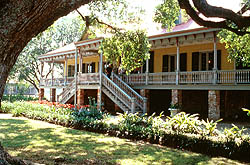External Links:
Growing Up White in the South
MTV's True Life episode titled "I'm a Southern Belle"
Source: Wikipedia
 The Houmas house, designed in the Greek Revival style Courtesy of Lagniappe Tours, Foundation for Historical Louisiana  Rear of The Houmas house Rear of The Houmas housePhotograph from National Register collection |
 Tezcuco-front entrance Tezcuco-front entranceCourtesy of Lagniappe Tours, Foundation for Historical Louisiana  Tezcuco's exterior extends to the restored landscape Tezcuco's exterior extends to the restored landscapeCourtesy of Lagniappe Tours, Foundation for Historical Louisiana |
 Madewood Plantation House Madewood Plantation HousePhotograph from the National Historic Landmark collection  Second floor collonade of Ionic columns Second floor collonade of Ionic columnsPhotograph from the National Historic Landmark collection |
 Double row of oak trees about Oak Alley Courtesy of Lagniappe Tours, the Foundation for Historical Louisiana  Oak Alley up close Oak Alley up closeCourtesy of Lagniappe Tours, the Foundation for Historical Louisiana |
 Judge Felix Poche Plantation House, front Judge Felix Poche Plantation House, frontCourtesy of Lagniappe Tours, the Foundation for Historical Louisiana  Judge Felix Poche Plantation House, front and side view Judge Felix Poche Plantation House, front and side viewPhotograph from National Register collection |
 Laura Plantation house Laura Plantation houseCourtesy of Lagniappe Tours, Foundation for Historical Louisiana  Two slave quarters at Laura Plantation Two slave quarters at Laura Plantation Courtesy of Lagniappe Tours, Foundation for Historical Louisiana |
 Pigeonnier and plantation store within the Whitney Plantation Historic District Pigeonnier and plantation store within the Whitney Plantation Historic DistrictCourtesy of the Louisiana Division of Historic Preservation  Historic district buildings including the Whitney Plantation Main House, plantation store, and French Creole barn Historic district buildings including the Whitney Plantation Main House, plantation store, and French Creole barnCourtesy of the Louisiana Division of Historic Preservation |
 Evergreen Plantation House Evergreen Plantation HousePhotograph from the National Historic Landmarks collection  The standard row pattern of slave quarters, lost throughout much of the South, can still be seen at Evergreen The standard row pattern of slave quarters, lost throughout much of the South, can still be seen at EvergreenPhotograph from the National Historic Landmarks collection |
 San Francisco Plantation House Courtesy of Lagniappe Tours, Foundation for Historical Louisiana  Historic view of San Francisco, c.1891 Historic view of San Francisco, c.1891Photograph courtesy of San Francisco Plantation and Lagniappe Tours |
 Homeplace Plantation House Homeplace Plantation HouseCourtesy of the Louisiana Division of Historic Preservation  Historic view of Homplace, c.1900 Historic view of Homplace, c.1900Photograph from National Register collection |
 Destrehan Plantation Destrehan Plantation Courtesy of Lagniappe Tours, Foundation for Historical Louisiana  Destrehan Plantation before renovation Destrehan Plantation before renovationPhotograph from National Historic Landmarks collection |
 Entryway to the Carter Plantation House Courtesy of the Louisiana Division of Historic Preservation  Rear of the Carter Plantation House Rear of the Carter Plantation HouseCourtesy of the Louisiana Division of Historic Preservation |
 Fritz Salmen House Courtesy of the Capital Resource Conservation and Development Council  Interior of the Salmen House Interior of the Salmen HousePhotograph from the National Register collection |
 Sullivan House Courtesy of the Capital Resource Conservation and Development Council{photo2} Rear view of historic site {courtesy2} |
 Cottage Plantation house, built with Doric columns Courtesy of Lagniappe Tours, Foundation for Historical Louisiana  Cottage Plantation, two buildings meet in "L" shape Courtesy of Lagniappe Tours, Foundation for Historical Louisiana |
 Catalpa Plantation House, surrounded by large oak trees Courtesy of Lagniappe Tours, Foundation for Historical Louisiana  Side view of Catalpa Photograph from National Register collection |
 Myrtles Plantation Courtesy of Lagniappe Tours, Foundation for Historical Louisiana  Myrtles Plantation and Gardens Courtesy of Lagniappe Tours, Foundation for Historical Louisiana |
 Butler--Greenwood Plantation, where 18th-century English gardens greet the visitor Butler--Greenwood Plantation, where 18th-century English gardens greet the visitorCourtesy of Capital Resource Conservation and Development Council{photo2} Rear view of historic site {courtesy2} |
![[photo] [photo]](http://www.nps.gov/nr/travel/louisiana/buildings/ros1.jpg) The Great House of Rosedown Plantation, as seen from the oak allee Photo from National Historic Landmarks collection ![[photo] [photo]](http://www.nps.gov/nr/travel/louisiana/buildings/ros2.jpg) View of Rosedown Plantation gardens View of Rosedown Plantation gardens Photo from National Historic Landmarks collection |
 Oakley Plantation House Oakley Plantation HouseCourtesy of the Capital Resource Conservation and Development Council  Kitchen and servants house located behind the main house Kitchen and servants house located behind the main housePhotograph from the National Register collection |
 Parlange Plantation House Courtesy of the Louisiana Division of Historic Preservation  Pigeonnier on grounds Pigeonnier on groundsCourtesy of the Louisiana Division of Historic Preservation |

 T-Clothes Line
T-Clothes Line